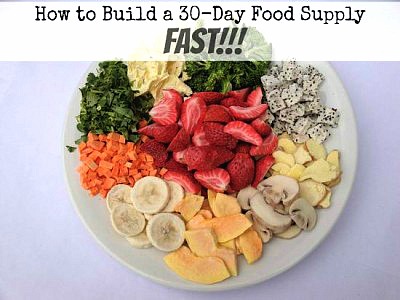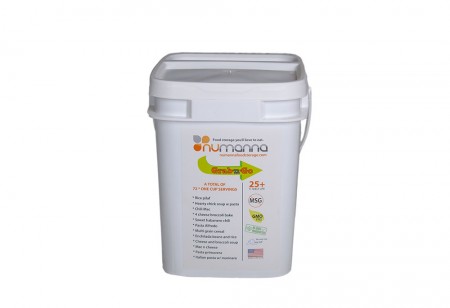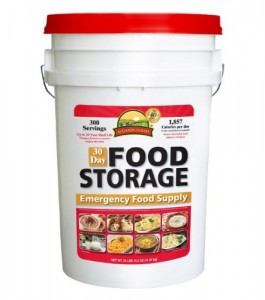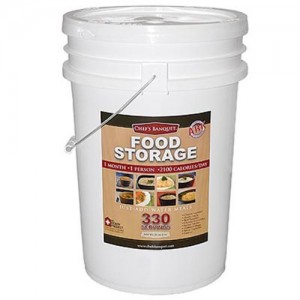If you're new here, you may want to subscribe to my RSS feed. Thanks for visiting!
By Daisy Luther
If you’ve been paying attention to the news lately, you may be feeling on edge. You may feel as though time is running out for you to get your preparedness supplies in order. You may be new to prepping, and feeling like there’s too much to accomplish. The stress in our country is at peak level. We’ve listened to the war drums beat louder. We’ve witnessed riots breaking out in cities across America. We’ve watched the bumbling efforts of officials to respond to natural disasters and potential pandemics. The economy is in a freefall, and terrorist groups are more active than ever before.
This feeling of urgency can make you feel hopeless and panicked, and that’s not productive. There’s no time for a lack of productivity. It’s time to focus and create your food supply…fast. If an event occurs during which you are unable to leave your home, you want to make certain that you can keep food on the table without waiting for a handout to be doled out at the whim of some government agency. Such an event could be a mandatory quarantine, self-imposed isolation due to a pandemic, civil unrest in your town, martial law, or even a terrible storm that leaves you stranded, with no access to the store.
Generally I write about healthy food. I write about focusing on whole foods without additives, and I firmly believe that is the very best way to build your food supply. I believe strongly in the value of a pantry that you will use day to day to nourish your family. You can learn how to build a pantry like that in this article that recounts building our own food stockpile from the beginning, and the book The Pantry Primer: A Prepper’s Guide to Whole Food on a Half Price Budget.
However, if you do not have a food supply waiting in your pantry, now is the time to focus on creating an emergency stockpile quickly. You can then add healthier options at your leisure. The quantities in this article are per person, so you’ll need to multiply this by the number of people in your home. You can order these items online and get them to your door within a couple of days.
Alternatively, you can shop around and try to find duplicates locally. You can also create a food plan, make a list, and go shopping, purchasing the highest quality items available, and repackaging them for longer shelf life.
However you opt to build your food supply, please don’t hesitate. If a worst case scenario occurred, the goal is to be able to feed your family for at least a month.
How much do you need?
There are a few different ways to calculate food storage, but I find breaking it down by serving size to be the most practical. Don’t rely on what a package calls a serving size – consider the appetites of your family. You might have a couple of big eaters and a couple of people with birdlike appetites. The lists below are based on serving sizes for an average adult.
Be sure to get a variety of different foods:
- 3 protein servings
- 5-8 fruits and vegetables
- 5 starchy carbohydrates
On a 2000 calorie per day diet, strictly based on long-term storage food, the LDS (Church of the Latter Day Saints) says the average adult would need:
- 5 pounds of beans
- 25 pounds of grains
- 5 pounds of sugars
- 2 pounds of fats
- 8 pounds of dairy
These are purely subjective numbers, however. For example, if your family is gluten-free, you might eat more protein and produce than starchy carbs. You must take into account your family’s health concerns, special needs, allergies, intolerances, likes, and dislikes. These are simply guidelines. Try to stick as close to your normal eating habits as possible, to lessen the stress of an already highly-wrought situation.
It’s also important to consider cooking times. If you never ever cook from scratch, will you suddenly want to make pots of beans and homemade bread? If the power goes out, will you have a way that you’ll be able to cook these foods?
Create a stockpile with emergency food buckets
If you’re trying to build a food supply quickly, consider ordering a bucket with a month’s supply of meals in it.
Here’s why every prepper should have some emergency food buckets stashed away:
- A lot of calories can be condensed into a very small amount of space.
- If you have the capacity to boil water during an emergency, a filling meal can be yours.
- They add variety and speed to an emergency food supply.
- Calorie for calorie, they’re lightweight and easily portable in the event of a bug-out scenario.
- They’re professionally packaged to have a 25-year shelf life, so you can get it, stick it in the back of your closet, and forget about it until you need it.
Now, the downside.
If you’re looking for ready-made meals, none of them are going to be completely without additives. This is impossible, because they’re made to last for 25 years, to take up minimal space, to cook up quickly and efficiently, and to taste reasonably good.
Some compromises must be made. Yes, emergency food buckets contain processed food, but you don’t have to let go of all of your focus on healthful choices.
You may look at the prices of these items and say, “Oh, I can’t afford this.” But you have to remember, this is enough food for an ENTIRE MONTH. At $150, that means you’re spending only $3 per day on food. It honestly doesn’t get much cheaper than that. There’s a variety of price points below, with the pros and cons of each. These were the prices at the time of publication.
You’ll notice on the list of extras that I recommended a gentle laxative. Some people, when dependent solely upon MREs or dehydrated foods, become constipated. I also recommended a high-quality multivitamin to help ensure you’re getting the nutrition you need.
Remember: these buckets are a one month supply PER PERSON. You will need one bucket for each member of your household for a complete one month supply.
My Favorite Choice:
NuManna One Month Grab-and-Go
The One Month Grab-and-Go by NuManna is my #1 choice for emergency food. While I’ve purchased other brands, NuManna is now the only product line we purchase. Why? Here’s the company’s vision statement:
NuManna believes that emergency food should be as healthy if not healthier than the food we eat on a daily basis. The effects of food on our overall health have never been a bigger concern. Chemical preservatives, food allergies, gluten intolerance, MSG, and certainly Genetically Modified (GMO) foods are all challenging our well-being.
NuManna Foods is well aware of these problems. The founders of NuManna have their own special dietary needs and were seeking storable foods with no Aspartame, or High Fructose Corn Syrup before NuManna began. GMO-free ingredients and gluten restricted options were also a high priority. They didn’t find storable food meals quite up to the standards set for their own family. So, they decided to create them and became one of the first storable food makers of its kind to offer such selective and chemically free products.
We understand customers with exacting standards. We understand how food intolerance can be overwhelming. We also realize the human body cannot eat preserved foods for an extended period of time without getting sick. Your food storage and emergency supplies should not be a health crisis. We work to meet and exceed your expectations and make it easy to find the high-quality storable foods you want and need without sacrificing flavor or value.
Allow our pursuit of quality preparedness food to overcome the frustration you may have felt in seeking out healthy food storage. Our standard packages are Certified 100% GMO-Free with no preservatives, no soy, or other controversial ingredients. We also offer complete Gluten Restricted buckets with the same chemical and preservative-free standard. Our foods are even free of Autolyzed Yeast Extract. NuManna is a true innovator in healthy and chemically free storable foods.
I haven’t found anything else in the storable industry with these standards, and I believe that this could raise the bar to the point that the industry is changed completely. At the time of publication, One Month Grab-and-Go bucket was $149.95. They don’t count things like drink mixes as “meals” which means each meal you pay for is actual food. Here’s what the bucket contains:
- Organic Quinoa
- Organic Black Chia Seeds
- Organic Sprouting Seeds
- Organic Brown Jasmine Rice
- Parboiled Rice
- Organic Spelt
And finally, Numanna offers a the gluten-free family pack for those with restricted diets. It contains:
Augason Farms 30 Day Food Emergency Disaster Bucket
The Augason Farms 30 Day Food Emergency Disaster Bucket contains 90 meals for one person. That’s 3 meals a day for a month. The daily caloric allotment is about 1850 calories, and the meals are “just add water”, so to prepare them, you only need the ability to boil water – this could come in very handy during a grid-down situation. This is about $90, including the shipping. The kit contains:
- Instant Potatoes (30 servings)
- Macaroni & Cheese (30 servings)
- Creamy Potato Soup (30 servings)
- Cheesy Broccoli Rice (30 servings)
- Creamy Chicken Rice (30 servings)
- Hearty Vegetable Blend (30 servings)
- Maple Brown Sugar Oatmeal (40 servings)
- Morning Moo’s Low Fat Milk Alternative (80 servings)
Chef’s Banquet Food Storage Bucket
The Chef’s Banquet Food Storage Bucket also contains 3 meals per day for a month. It’s a little bit more expensive at $126, including shipping, but it doesn’t contain any High Fructose Corn Syrup or MSG, making it a higher quality choice than the Augason Farms. This is also a “just add water” menu, but there isn’t a lot of variety and there is a whole lot of mashed potatoes:
- Oatmeal – 60 Servings
- Hearty Potato Soup – 60 Servings
- Chicken Vegetable Stew – 30 Servings
- Mixed Vegetables – 30 Servings
- Instant Potatoes – 60 Servings
- Pasta – 30 Servings (includes 30 Servings of Cheddar Cheese Sauce)
- Beef Flavored Vegetable Stew –
- 30 Servings Cheddar Broccoli Rice – 30 Servings
And for the love of all things cute and fluffy….get one of these and make your life easier!!!!
You don’t have to be a prepper to build a 30-day food supply.
Up until recently, preppers have had something of a bad name in the media. However, as disasters strike America over and over, people are beginning to see the value in the way we do things. It’s been proven time and time again that when issues occur, you’re completely on your own. To learn more about basic preparedness, go HERE to learn how to get started.
Finally, if you want to learn more, here are some books and websites that can help you on your journey.
The Pantry Primer: A Prepper’s Guide to Whole Food on a Half Price Budget
The Prepper’s Blueprint: The Step-By-Step Guide To Help You Through Any Disaster



















33 Responses
Very informative timely article. A simpler method for surviving the coming and inevitable economic implosion is available for free at amazon if you are a member. Get “Yankee Anti Zombie Survival Manual “with its 101 rules that will save your life. A simple summation with pragmatic advice. A wake up call.
That food looks very good, compared to my mre and freeze dried.
Good article daisy,
Ive tried to get a pretty good supply together, usually funds are pretty tight, but when I go to costco I try to get at least 2 or 3 extra items, like extra canned veggies, or a case of spam or pasta, or dried fruits, or an extra bag of rice.
as a result I have stored up a pretty good stash and without being too much of a drain financially, and mostly stuff we will eat, obviously not eating a lot of spam or canned corned beef but it has a long shelf life, and in fact is still good way beyond the best by date, so is a good source of food, especially if there is not any other coming. have tried to store stuff too that will make the whole mess more interesting to cook into something, like chinese style noodles, or different stuff to make pasta salads, Mayo that doesnt need refridgeration to make cole slaw dressing for our Kale slaw, just little things that you may take for granted normally but witch will be a nice treat when the lights go off and dont come back on.
Anyway, Thanks for the articles,, keep em coming!
I know it’s not exactly in the same vein as these types of foods, but if you have the means, you can can your own meals. A pint size jar is usually enough for one person per meal. You can make a lot of chili for real cheap and use the box the jars came in to store them. The benefit of course is less water or no water when reheating, less fuel to heat (reheating isn’t even needed), and you get a home cooked meal in a time of crisis which is a morale booster. Combine home cooked meals with freeze dried, and you get the best of two worlds.
Daisy, thanks for the links in this article. But I can’t spend $130 on food at one time. Help me!
Hi ME2. I understand your concern – it’s a lot of money.
Please keep in mind that the $130 price tag is for an entire month of food. Broken down into meals 90 meals, it’s just over a dollar per meal per person. But purchasing in kits like this is the speedy option. By purchasing items on your own, on sale, you can do it less expensively.You can check your local sales and put together your own supply using the serving amounts in the article. Focus on beans, rice, oatmeal, peanut butter, canned fruits, canned vegetables, and dry milk.
I hope this helps. By adding some supplies each week, you’ll have your stockpile put away very quickly.
Daisy
Hi Daisy,
How would I store the items so bugs, mice, etc. doesn’t get in it. I’m thinking of for instance oatmeal in a plastic bag in a bucket with a tight sealed top? I’d do the same for the beans, etc. What do you think?
Thank you,
Amy
Hi Amy, Daisy,
I had been thinking of that same issue as Amy and have come up with the idea of using plastic coolers with wheels. We have some younger children and in case of SHTF they can help move the survival kits if we we have to bug out.
The coolers can stack well in the vehicle or at home (hidden under tables. . .).
The coolers (if picked the correct sizes) could protect survival packs as well.
Hi Daisy, What are your thoughts of using a personal dehydrator then vacuum packing fruits / vegetables and maybe meats?
Be blessed.
Poly
By chance do you have an Aldi’s in your area? You could get a few basics (inexpensively) and build from there.
Looks great but after wasting my time on the LDS website signing up, they don’t offer what you are showing. Also your pricing is wrong once you click on links for certain things, i.e. Freeze dried vegetable variety. Feel like you wasted my time. Thanks.
Hi, Jen. I’m sorry you had a bad experience. These were the prices when I published the article. Amazon changes prices frequently, and if there is a high demand, it’s possible that the prices were raised. Let me know if I can answer any specific question for you.
Daisy
Hi, Daisy.
Interested in the food packs from LDS but i could only find a few. Do you know if they still have all these packs you showed?
Thank you.
Jen
Hi Jen:
If you can’t find them to order online, try locating an LDS cannery or store near you. It may be a bit of a drive, but it’s worth it to get that awesome, already packaged food. Here’s a link to a locator.
http://store.lds.org/webapp/wcs/stores/servlet/StoreLocationsView?catalogId=10557&langId=-1&storeId=715839595
Sometimes the hours are not normal business hours, so be sure to call first. Some of the stores were shut down by the government last year, also, which has made supplies harder to come by. One other option would be to contact an LDS church local to you and ask them if they have any suggestions for acquiring the self-reliance products. It’s possible that they do bulk orders for their congregants and that you might be able to get in on that.
Daisy
It’s there…
http://store.lds.org/webapp/wcs/stores/servlet/Product3_715839595_10557_3074457345616706370_-1__195787
The LDS website has a lot of #10 can sizes for a much cheaper price, but they do not sale “90-day” food packages like the buckets she was talking about.
Charisse – you’re right. They are cheaper (and we have lots of them in our stockpile – the old “starter kits” with 6 items.) The unfortunate thing is, most of the items require a long cooking time. Hard wheat, beans, etc., will use up a lot of fuel during a power outage. They are fantastic to have on the shelf though, and I highly recommend them. These items are things that you can fix fairly quickly with the ability to boil some water. 🙂
Good post Daisy.
“By adding some supplies each week, you’ll have your stockpile put away very quickly”.
I too am on a tight budget but have been doing what you suggested above for the some time now and have a decent supply of grub put away.
Thanks for all of the good stuff you put together. Fred
Hi Daisy, I’m new to the site – love it so far! I’ve put together a several-month supply of meals from Walmart that only require boiled water, but I did shop around for some mail-order food supplies too. I’ve noticed that the mail-order companies claim very long shelf life, up to 25 years, whereas my WalMart goods have dates on them. Could you do a post topic on realistic shelf life of cheap canned or dried foods from the regular store? I know there is a legal difference between “Best By” and “Use By,” but I’ve always just eaten canned or dried foods long after the dates printed, as long as they smelled right when opened. I reckon that boiling things like rice or pasta would kill anything that could be harmful over time, so eat up!?
Thanks again, keep up the good work!
Adam
I think slow and stead is also a great approach if you are on a budget. Putting a few items into your shopping basket on each trip to the store really does make a difference.
That is how I started and gradually built up to a full years worth of food and water for a family of 4.
I stock mostly dried foods that will store for a long time. they key thing there is to have enough water to rehydrate and cool it all…! 🙂
– Dave
Dave,
How are you storing your dried items? In plastic bags and then in a bucket?
Thank you,
Amy
At the very beginning you should give your phone number, E-mail address and address. I have a few questions but you did not include your phone number or E-mail address ???!!! I want to purchase a year supply of survival for a year.
Vince
Vince, these products are available through Amazon, not through me directly. 🙂
If there are any organic survival food companies which are the best for value and taste? Do they offer any sample packs?
I don’t know of any survival food companies that are strictly organic. These were the best options I as able to find.
Hi Daisy, I like your info, building my own long term food storage is a good idea and I know that I will actually eat the food that I buy. The main problem that I’ve found with buying “kits” is that they include a lot of foods that I probably wouldn’t eat unless I were really hungry. The first long term food storage company that creates a website where you/I can “check” individual items that will allow you/I to build our own “kits” with the foods that we like will have my business!
My husband, and therefore me, is on a doctor prescribed grain-free diet due to arthritic inflammation. Any options in prepackaged meals for us you know of? Thanks
Karen – we also eat largely a grain-free diet, too, and I haven’t been able to find any specific pre-packaged meals that are grain-free. I suggest that you purchase dehydrated meats, dairy products, fruits, and vegetables and combine these into your own meals. It isn’t as convenient but it’s likely to be far healthier than anything pre-made that you would buy.
My daughter is allergic to most additives in processed foods. My husband and I have our emergency packs but have very little for her. I need to know what is used in your foods to see if she could tolerate your foods. Thank you for your help.
Gail Jacobs
Hi Gail.
The issue that you will run into is that most emergency foods have additives, which are a necessity for long term storage of these meals. Here’s a list of foods offered on my site. If you click on the food, you can read the ingredients and find the nutrition information.
http://preppersmarket.com/ingredients-2/
Within the week, we’ll be adding a 100% organic option to the site, so be sure to check back!
Try Thrive foods they are individual foods that have been freeze dried without additives and are great to make individual ready to eat meals with!
Hi! I was wondering if you have opened and tried some of these meals? I have read in some places that most of the calories are from drinks, the servings are only about 1/2 cup, and there really isn’t enough meals for a 2000 calorie per day diet, which is recommend. I think they are a great quick way to gather a 90-day supply, but feel if they only support a 500 calorie diet, then you may want more than 1 bucket for a month supply…. which will start adding up in price and making it very expensive.
These don’t include drinks. I think the meals are in the 300 or so calorie apiece range. Each pouch contains 6 servings, so when I make them for my daughter and myself, we shake the pouch, scoop out small portions and zip it back up. (The pouches have a ziplock-style seal at the top.)
Ok thanks! That’s good to know!